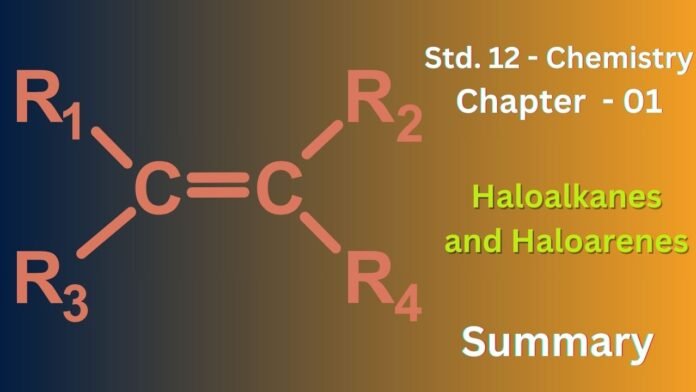1. Haloalkanes and Haloarenes
Haloalkanes and haloarenes are organic compounds in which one or more hydrogen atoms in an alkane or arene are replaced by halogen atoms (fluorine, chlorine, bromine, or iodine). Haloalkanes are compounds in which the halogen atom is attached to an sp3 hybridized carbon atom, while haloarenes are compounds in which the halogen atom is attached to an sp2 hybridized carbon atom in an aromatic ring.
Haloalkanes and haloarenes are classified based on the number of halogen atoms present in the molecule. They can be mono-, di-, tri-, or polyhalogenated compounds. They are also classified as primary, secondary, or tertiary depending on the degree of substitution of the carbon atom to which the halogen is attached.
The nomenclature of haloalkanes and haloarenes follows the IUPAC system. Haloalkanes are named by prefixing the name of the halogen atom to the name of the parent alkane. Haloarenes are named by prefixing the name of the halogen atom to the name of the parent aromatic hydrocarbon.
Haloalkanes and haloarenes are prepared by a variety of methods, including:
- Halogenation of alkanes and arenes
- Addition of hydrogen halides to alkenes and alkynes
- Reaction of alcohols with hydrogen halides or phosphorus halides
- Halogen exchange reactions
Haloalkanes and haloarenes undergo a variety of reactions, including:
- Nucleophilic substitution reactions
- Elimination reactions
- Reactions with metals
Haloalkanes and haloarenes are used in a variety of applications, including:
- Solvents
- Refrigerants
- Anesthetics
- Pesticides
- Pharmaceuticals
Some polyhalogen compounds, such as dichloromethane, chloroform, and carbon tetrachloride, have important industrial applications. However, many polyhalogen compounds are also toxic and environmentally harmful. For example, DDT, a once widely used pesticide, has been shown to have harmful effects on wildlife and humans. Freons, which were widely used as refrigerants, have been shown to deplete the ozone layer.
The chapter on haloalkanes and haloarenes in the 12th standard NCERT chemistry textbook provides a comprehensive overview of these important classes of organic compounds. The chapter covers the classification, nomenclature, preparation, reactions, and uses of haloalkanes and haloarenes. The chapter also discusses the environmental impact of some polyhalogen compounds.
Exercise
1. Name the following halides according to the IUPAC system and classify them as alkyl, allyl, benzyl (primary, secondary, tertiary), vinyl, or aryl halides:
(i)(CH3)2CHCH(Cl)CH3
(ii) CH3CH2CH(CH3)CH(C2H5)CI
(iii) CH3CH2C(CH3)2CH2I
(iv)(CH3)3CCH2CH(Br)C6H5
(v)CH3CH(CH3)CH(Br)CH3
(vi)CH3C(C2H5)2CH2Br
(vii)CH3C(Cl)(C2H5)CH2CH3
(viii)CH3CH=C(CI)CH2CH(CH3)2
(ix)CH3CH=CHC(Br)(CH3)2
(x)P-CIC6H4CH2CH(CH3)2
(xi)m-ClCH2C6H4CH2C(CH3)3
(xii)o-Br -C6H4CH (CH3)CH2CH3
Ans :
(i) (CH3)2CHCH(Cl)CH3
- IUPAC Name: 2-Chloro-3-methylbutane
- Classification: Alkyl (Secondary)
(ii) CH3CH2CH(CH3)CH(C2H5)Cl
- IUPAC Name: 3-Ethyl-2-methylpentane
- Classification: Alkyl (Secondary)
(iii) CH3CH2C(CH3)2CH2I
- IUPAC Name: 2,2-Dimethylbutane
- Classification: Alkyl (Primary)
(iv) (CH3)3CCH2CH(Br)C6H5
- IUPAC Name: 2-Bromo-3,3-dimethyl-1-phenylpropane
- Classification: Benzyl (Secondary)
(v) CH3CH(CH3)CH(Br)CH3
- IUPAC Name: 2-Bromo-3-methylbutane
- Classification: Alkyl (Secondary)
(vi) CH3C(C2H5)2CH2Br
- IUPAC Name: 2-Ethyl-2-methylbutane
- Classification: Alkyl (Primary)
(vii) CH3C(Cl)(C2H5)CH2CH3
- IUPAC Name: 3-Chloro-3-methylpentane
- Classification: Alkyl (Tertiary)
(viii) CH3CH=C(Cl)CH2CH(CH3)2
- IUPAC Name: 3-Chloro-4-methyl-2-pentene
- Classification: Allyl
(ix) CH3CH=CHC(Br)(CH3)2
- IUPAC Name: 2-Bromo-2-methyl-3-pentene
- Classification: Allyl
(x) p-ClC6H4CH2CH(CH3)2
- IUPAC Name: 1-(4-Chlorophenyl)-2-methylpropane
- Classification: Benzyl (Secondary)
(xi) m-ClCH2C6H4CH2C(CH3)3
- IUPAC Name: 1-(3-Chloromethylphenyl)-2,2-dimethylpropane
- Classification: Benzyl (Primary)
(xii) o-Br-C6H4CH(CH3)CH2CH3
- IUPAC Name: 1-(2-Bromophenyl)-2-methylpropane
- Classification: Benzyl (Secondary)
2. Give the IUPAC names of the following compounds:
(i) CH3CH(CI)CH (Br)CH3 (ii) CHF2CBrCIF (iii) CICH2C=CCH2Br (iv) (CCl3)3CCl
(v)CH3C(p-ClC6H4)2CH(Br)CH3 (vi)(CH3)3CCH=C(CI)C6H4I -p
Ans :
(i) CH3CH(Cl)CH(Br)CH3
- IUPAC Name: 2-Bromo-3-chlorobutane (Alphabetical order of halogens)
(ii) CHF2CBrClF
- IUPAC Name: Bromochlorodifluoromethane (Alphabetical order of halogens)
(iii) ClCH2C≡CCH2Br
- IUPAC Name: 1-Bromo-3-chloro-2-propyne
(iv) (CCl3)3CCl
- IUPAC Name: 2-(Trichloromethyl)-1,1,1,3,3,3-hexachloro-2-propane (or simply Perchloroisobutane). The longest continuous carbon chain is the propane backbone. The three CCl3 groups are each attached to the central carbon.
(v) CH3C(p-ClC6H4)2CH(Br)CH3
- IUPAC Name: 2-Bromo-2-[bis(4-chlorophenyl)methyl]propane
(vi) (CH3)3CCH=C(Cl)C6H4I-p
- IUPAC Name: 1-Chloro-2-(4-iodophenyl)-3,3-dimethyl-1-butene
3. Write the structures of the following organic halogen compounds:
(i)2-ChIoro-3-methylpentane
(ii)p-Bromochlorobenzene
(iii)l-Chloro-4-ethylcyclohexane
(iv)2r (2-Chlorophenyl) -1- iodooctane
(v)2-Bromobutane
(vi)4-tert-Butyl-3-iodoheptane
(vii)1-Bromo-4-sec-butyl-2-methylbenzene
(viii)1,4-Dibromobut-2-ene
Ans :
4. Which one of the following has the highest dipole moment?
(i)CH3CI2 (ii) CHCl3 (iii) CCI4
Ans :
CHCl3 (chloroform) has the highest dipole moment among the given options.
- CCl4 (Carbon tetrachloride): It has a symmetrical tetrahedral structure. 1 The individual bond dipoles (C-Cl) cancel each other out due to this symmetry, resulting in a net dipole moment of zero.
- CH2Cl2 (Dichloromethane): It has a tetrahedral structure but is less symmetrical than CCl4. It possesses a net dipole moment, but it’s not the highest among these three.
- CHCl3 (Chloroform): Although it’s also tetrahedral, it has the least symmetry, making it more polar. The three C-Cl bonds’ dipole moments don’t completely cancel out because there is one C-H bond present. This C-H bond has a small but opposite dipole that enhances the net pull of the other three chlorines.
5. A hydrocarbon C5H10 does not react with chlorine in dark but gives a single monochloro compound C5H9CI in bright sunlight. Identify the hydrocarbon.
Ans :
The hydrocarbon is cyclopentane.
Here’s the reasoning:
- C5H10 formula: This formula indicates the hydrocarbon could be either an alkene (with a double bond) or a cycloalkane (a ring structure).
- No reaction with chlorine in the dark: Alkenes readily react with chlorine in the dark due to the presence of the double bond. Since the hydrocarbon doesn’t react in the dark, it cannot be an alkene. This strongly suggests it’s a cycloalkane.
- Single monochloro compound in bright sunlight: Cycloalkanes react with chlorine in the presence of sunlight via a free radical substitution mechanism. A single monochloro compound is formed when all the hydrogen atoms in the molecule are equivalent. This means they are all in the same chemical environment as a result of symmetry. This highly symmetrical structure is found in cyclopentane, where all the hydrogens are equivalent. If it were any other cycloalkane like methylcyclobutane, multiple monochlorinated products would be produced.
Therefore, the only C5H10 hydrocarbon that fits both criteria is cyclopentane.
6. Write the isomers of the compound having formula C4H9Br.
Ans :
7. Write the equations for the preparation of 1-iodoobutanefrom (i)1-butanol (ii)1-chlorobutane (iii) but-l-ene.
Ans :
8. What are ambident nucleophiles ? Explain with an example.
Ans : Ambident nucleophiles are nucleophiles that possess two (or more) nucleophilic centers, meaning they can attack an electrophile from two (or more) different sites. This leads to the possibility of forming different products depending on which nucleophilic center attacks.
Example:
The cyanide ion (CN⁻) is a classic example of an ambident nucleophile. It can attack an electrophile through either the carbon atom or the nitrogen atom.
9. Which compound in each of the following-pairs . will react faster in SN2 reaction with -OH? (i)CH3Br or CH3I (ii)(CH3)3CCl or CH3Cl
Ans :
(i) CH3Br or CH3I:
CH3I (methyl iodide) will react faster.
- Reason: SN2 reactions are sensitive to steric hindrance and the strength of the C-X bond (where X is the halogen). Iodide (I⁻) is a better leaving group than bromide (Br⁻) because the C-I bond is weaker and longer. A weaker bond means it breaks more easily, facilitating the SN2 reaction. Sterically, both molecules are similarly unhindered, but the C-I bond is significantly weaker than the C-Br bond.
(ii) (CH3)3CCl or CH3Cl:
CH3Cl (methyl chloride) will react faster.
- Reason: SN2 reactions are strongly inhibited by steric hindrance.
The bulky tert-butyl group in (CH3)3CCl creates significant steric hindrance around the carbon atom bonded to the chlorine. This crowding makes it difficult for the nucleophile (-OH in this case) to approach and attack the carbon from the opposite side (the backside attack characteristic of SN2 reactions). CH3Cl, on the other hand, has minimal steric hindrance, allowing for a much faster SN2 reaction.
10. Predict all the alkenes that would be formed by dehydrohalogenation of the following halides with sodium ethoxide in ethanol and identify the major alkene:
(I) 1-Bromo-l-methylcyclohexane
(ii) 2-Chloro-2-methylbutane.
(iii) 2,2,3-Trimethyl-3-bromopentane.
Ans :
Dehydrohalogenation with sodium ethoxide in ethanol is an E2 elimination reaction, meaning it’s a concerted reaction where a proton and a halide ion are removed from adjacent carbon atoms, forming a double bond. Zaitsev’s rule states that the major product in an elimination reaction is the most substituted alkene (the alkene with the most alkyl groups attached to the double bond carbons).
Here’s a breakdown for each halide:
(i) 1-Bromo-1-methylcyclohexane:
- Possible Alkenes: Two alkenes are possible due to the two different sets of beta-hydrogens available for elimination.
- 1-Methylcyclohexene: The major product (more substituted).
- Methylenecyclohexane: Less substituted.
- Major Alkene: 1-Methylcyclohexene
(ii) 2-Chloro-2-methylbutane:
- Possible Alkenes: Two alkenes are possible due to the two different sets of beta-hydrogens available for elimination.
- 2-Methyl-2-butene: The major product (tetrasubstituted).
- 2-Methyl-1-butene: Less substituted.
- Major Alkene: 2-Methyl-2-butene
(iii) 2,2,3-Trimethyl-3-bromopentane:
- Possible Alkenes: Only one alkene can be formed.
- 2,3,3-Trimethyl-2-pentene: Only one set of beta-hydrogens is available for elimination.
- Major Alkene: 2,3,3-Trimethyl-2-pentene (This is the only product, so it is the major product by default.)
11. How will you bring about the following conversions?
(I) Ethanol to but-l-yne.
(ii) Ethane to bromoethene
(iii) Propene to 1-nitropropane
(iv) Toluene to benzyl alcohol
(v) Propene to propyne
(vi) Ethanol to ethyl fluoride
(vii) Bromomethane to propanone
(viii) But-l-ene to but-2-ene
(ix) 1-Chlorobutane to n-octane
(x) Benzene to biphenyl
Ans :
12. Explain why
(i) the dipole moment of chlorobenzene is lower than that of cyclohexyl chloride?
(ii) alkyl halides, though polar, are immiscible with water?
(iii) Grignard reagents should be prepared under anhydrous conditions?
Ans :
(i) The dipole moment of chlorobenzene is lower than that of cyclohexyl chloride:
- Resonance in Chlorobenzene: In chlorobenzene, the chlorine atom’s lone pair of electrons participates in resonance with the benzene ring. This resonance creates a partial double bond character between the carbon and chlorine, effectively reducing the electron density on the chlorine atom. This delocalization of electrons decreases the magnitude of the dipole moment.
- No Resonance in Cyclohexyl Chloride: Cyclohexyl chloride is an aliphatic compound. There’s no resonance possible, so the chlorine atom retains its full electron density. The C-Cl bond is a typical single bond, and the dipole moment arises from the electronegativity difference between carbon and chlorine.
- Result: Because of resonance, the C-Cl bond in chlorobenzene is less polar than the C-Cl bond in cyclohexyl chloride. This difference in bond polarity leads to a smaller overall dipole moment for chlorobenzene.
(ii) Alkyl halides, though polar, are immiscible with water:
- Polarity vs. Hydrogen Bonding: Alkyl halides are polar molecules due to the electronegativity difference between carbon and the halogen atom. However, they cannot form strong hydrogen bonds with water molecules. Hydrogen bonding requires a hydrogen atom directly bonded to a highly electronegative element like oxygen, nitrogen, or fluorine. While alkyl halides are polar, they lack this H atom directly bonded to an electronegative atom.
- Hydrophobic Nature: The alkyl group (R) in alkyl halides is typically a nonpolar, hydrophobic (water-repelling) group. This large nonpolar part of the molecule dominates the interaction with water.
- Result: The weak dipole-dipole interactions between alkyl halide molecules and water are not strong enough to overcome the stronger hydrogen bonds between water molecules themselves. Therefore, alkyl halides are essentially immiscible with water.
(iii) Grignard reagents should be prepared under anhydrous conditions:
- Reaction with Water: Grignard reagents (RMgX) are extremely reactive towards protic solvents, including water. They react violently with water to form hydrocarbons and magnesium hydroxide halide.
RMgX + H2O → RH + Mg(OH)X
- Loss of Reagent: This reaction with water destroys the Grignard reagent, which is a strong base.
13. Give the uses of freon 12, DDT, carbon tetrachloride, and iodoform.
Ans : While some of these compounds were widely used in the past, it’s important to note that many have been phased out or banned due to their harmful environmental and health effects. Here’s a look at their uses, with that important caveat:
Freon-12 (Dichlorodifluoromethane, CF2Cl2)
- Refrigerant: Primarily used in refrigerators and air conditioning systems due to its effective heat absorption properties.
- Aerosol Propellant: Formerly used in aerosol spray propellants for products like hair sprays and deodorants.
Important Note: Freon-12 is a chlorofluorocarbon (CFC) that is a major contributor to ozone depletion. Its production and use have been largely phased out under international agreements like the Montreal Protocol.
DDT (Dichlorodiphenyltrichloroethane)
- Insecticide: Highly effective against a wide range of insects, including mosquitoes (malaria vector) and lice. It was widely used in agriculture and public health programs.
Important Note: DDT’s use is now restricted or banned in many countries due to its persistence in the environment, its bioaccumulation in organisms, and its potential harm to wildlife and human health.
Carbon Tetrachloride (CCl4)
- Industrial Solvent: Used as a solvent in various industrial processes, including the production of other chemicals.
- Refrigerant and Propellant: Used in the manufacture of some refrigerants and as a propellant in aerosol cans.
- Cleaning Agent: Historically used as a cleaning fluid, degreasing agent, and in fire extinguishers.
Important Note: Carbon tetrachloride is a toxic and volatile compound. It is a known carcinogen and can cause damage to the liver and nervous system. Its use is now highly regulated or banned in many applications.
Iodoform (CHI3)
- Antiseptic: Used as an antiseptic due to its ability to release iodine, which has antimicrobial properties. It was used in wound dressings and as a disinfectant.
Important Note: Iodoform has a strong, unpleasant odor, and its use as an antiseptic has largely been replaced by other iodine-containing formulations that are more effective and less odorous.
14. Write the structure of the major organic product in each of the following reactions:
Ans :
15. Write the mechanism of the following reaction:
Ans :
KCN is a resonance hybrid of the following two contributing structures:
16. Arrange the compounds of each set in order of reactivity towards SN2 displacement:
(i) 2-Bromo-2-methyibutane, 1-Bromopentane, 2-Bromopentane.
(ii) l-Bromo-3-methyIbutane, 2-Bromo-2-methylbutane, 3-Bromo-2-methylbutane.
(iii) 1-Bromobutane, l-Bromo-2,2-dimethylpropane, l-Bromo-2-methylbutane, l-Bromo-3-methyl butane.
Ans :
17. Out of C6H5CH2Cl and C6H5CHCIC6H5which is more easily hydrolysed by aqueous KOH.
Ans :
While the benzhydryl carbocation is more stable, the steric hindrance in benzhydryl chloride makes it react slower in an SN1 hydrolysis than the less sterically hindered benzyl chloride, which forms a less stable, but still significantly resonance-stabilized carbocation.
18. p-dichlorobenzene has higher m.p. and lesser solubility than those of o-and m-isomers. Discuss.
Ans :
The higher melting point of para-dichlorobenzene is due to its symmetrical structure and efficient crystal packing, leading to stronger intermolecular forces.
The lower solubility is a consequence of its higher lattice energy, which makes it more difficult to dissolve in a solvent like water.
19. How the following conversions can be carried out:
(i) Propene to propan-l-ol (ii) Ethanol to but-l-yne
(iii) l-Bromopropane to 2-bromopropane (iv) Toluene to benzyl alcohol
(v)Benzene to 4-bromonitrobenzene (vi) Benzyl alcohol to 2-phenylethanoic acid
(vii)Ethanol to propanenitrile (viii) Aniline to chlorobenzene
(ix)2-Chlorobutane to 3,4-dimethylhexane (x) 2-Methyl-1 -propene to 2-chk>ro-2-methylpropane.
(xi)Ethyl chloride to propanoic acid (xii) But-1-ene to n-butyliodide
(xiii)2-Chlropropane to 1-propanol (xiv) Isopropyl alcohol to iodoform
(xv)Chlorobenzene to p-nitrophenol (xvi) 2-Bromopropane to 1-bromopropane
(xvii)Chloroethane to butane , (xviii) Benzene to diphenyl
(xix) tert-Butyl bromide to isobutyl bromide (xx) Aniline to phenylisocyanide
Ans :
20. The treatment of alkyl chlorides with aqueous KOH leads to the formation of alcohols but in presence of alcoholic KOH, alkenes are major products. Explain.
Ans :
- Aqueous KOH: Favors substitution (SN1 or SN2) due to the hydroxide ion acting as a good nucleophile in a polar protic solvent. This leads to the formation of alcohols.
- Alcoholic KOH: Favors elimination (E1 or E2) because the alkoxide ion is a strong, bulky base that preferentially abstracts a proton, facilitated by the less polar environment. This leads to the formation of alkenes.
The choice of solvent and base is crucial in directing the reaction towards either substitution or elimination.
21. Primary alkyl halide C4H9Br (a) reacted with alcoholic KOH to give compound (b) Compound (b) is reacted, with HBr to give (c) which is an isomer of (a). When (a) is reacted with sodium metal it give compound (d), C8H18 which is different from the compound formed when n-butyl bromide is reacted with sodium. Give the structural formula of (a) and write the equations for all the reactions.
Ans :
(i)
(ii)
(iii)
(iv)
22. What happens when .
(i) n-butyi chloride is treated with alcoholic KOH.
(ii) bromobenzene is treated with Mg in the presence of dry ether.
(iii) chlorobenzene is subjected to hydrolysis.
(iv) ethyl chloride is treated with aqueous. KOH.
(v) methyl bromide is treated with sodium in the presence of dry ether,
(vi) methyl chloride is treated with KCN.
Ans :


